Advertisement
Owning one boat may be a lifetime commitment for some, but swapping old faithful for a vessel that better suits your lifestyle today can keep you in boating.
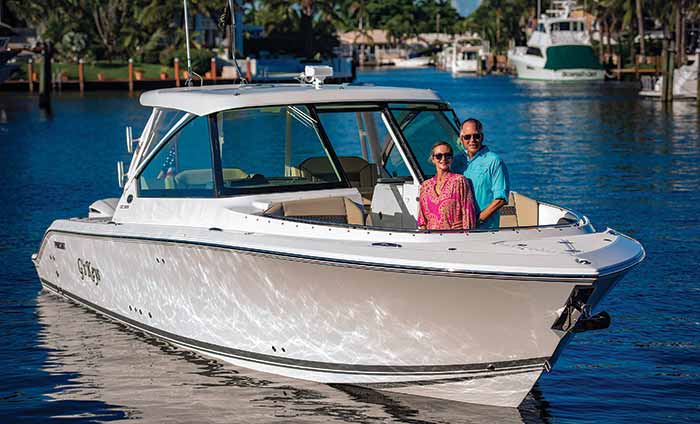
Gary and Ingrid Rex's Pursuit DC 325 allows them to enjoy both local and long-range cruising.
Anyone who spends a good chunk of their lives on the water will proudly recount the various craft they've enjoyed across the sweep of their boating life. The chronology generally follows an upward trend, starting with a modest skiff or sailing dinghy and navigates through increasingly bigger and better boats.
But just as our wants, needs, and priorities change at various life stages, so do the boats that fit our lifestyle. There's "moving up" and "downsizing," but what about switching boats simply for a lifestyle adjustment. Sailors jumping over to power as they age is a common theme, but what about the angler who trades in the center-console for a pontoon boat to spoil the grandkids? Or from a hard-core sportfishing machine to a plush family cruiser? People make adjustments in their lives for all kinds of reasons.
Bottom line: You need a boat that matches your lifestyle, or you're bound to use it a whole lot less — and nothing eats at a boater more than the thought that she or she is just not using the boat enough. The goal is to stay in boating, and sometimes that requires making a change.
Cost-Conscious Consumers
Consider the long boating arc of John Gray, who grew up on small-class racing sailboats at the San Diego Yacht Club. After a break from boating to build his career, Gray resumed his love for the water when the family relocated to Washington, near Puget Sound, where he introduced his wife, Laurie, to boating. For 10 years, they cruised on sailboats that had one thing in common: they were project boats that needed repairs and upgrades. When their two children got too busy for sailing, the family moved to a well-used 24-foot Bayliner cruiser for 10 years, which the kids loved for its speed, but, to Laurie, the scenery and wildlife went by too fast to enjoy.
When the kids moved on to college and careers, the couple hunted for a trailerable trawler, a boat that was efficient to operate, comfortable for two to cruise, and was easily transportable.
"The lower costs of operating a trawler fits our budget and our values," Laurie says. "We stay at a location no longer than three nights and enjoy anchoring. The cruise is the end-goal, not the destination, and 8 knots is our perfect speed as there is time to look, research, and talk about what we see along the way." Today, they've logged more than 10,000 miles on first a 25-foot then a 29-foot Ranger Tug, cruising extensively through the Pacific Northwest and the Great Loop.
Close Comfort
Flint and Leslie Firestone spent the 1980s chartering various sailboats in Chesapeake Bay before transitioning to small fishable powerboats in the 1990s. They leapt at a trawler, a Present 42 Sundeck, specifically to navigate the fabled Great Loop.
"We had sold our home the year before, so we were all in. The intention was to sell the boat after the Loop and build a home on our land in South Carolina," Leslie says. "We loved the cruising lifestyle so much that the plan went out the window. We have been cruising full time since."
Today, they live aboard a 26-foot C-Dory Venture over the winter months in the Florida Keys. The rest of the year, they cruise the U.S. and Canada in a 35-foot RV.
"We have been married 52 years and we still like each other, so we can live life on a small boat," says Flint. "Not everyone can live this kind of life, but it suits us and we will live it as long as our health is good."
The Elusive Stinkpotter-Turned-Sailor
Norm Hittinger was a powerboater most of his life — from small open boats with outboards to cabin cruisers — and assumed he would remain one. But then … "a friend of mine took my wife and me on a sailing trip in the British Virgin Islands and we just loved it," Norm says. "Soon after, we attended sailing school and started bareboating in the Bahamas," Norm says. They discovered the appeal of chartering off-season when they'd "mix with the locals and loved it."
After Norm retired from the Ford Motor Company in 1993, the couple purchased a 38-foot Hunter sailboat and logged more than 10,000 miles of sailing on the Great Lakes over 16 years. "Both my wife and I agree it was the best decision we ever made," he says. "So many stories and experiences!"
Additional Advice
We tell anyone interested in making a transition to a different kind of boat to make sure they look at all aspects of what the change entails. If it is bigger, will you be able to handle it with the crew you have? Will it cost more to dock and maintain it? If you are going smaller, can you be comfortable in a small space, and are you willing to give up the stuff you normally use if it doesn't fit? Do you have a vehicle to safely tow it, if it is a trailerable boat?
— Flint & Leslie Firestone
Work closely with your partner to clarify what your own style of boating is, including what you like, need, and what you do not want (and why). There are as many types of boats as there are boating styles; match the boat to your style. Also, realize there is never a perfect time for a change. Don't wait to follow your dreams because there will always be a dozen good reasons or distractions to convince you to stay in port.
— John & Laurie Gray
Tales From BoatUS Members
We asked you, our Members, for your "changing boats" stories — and you delivered!
Beat The Clock

Gene and Bobbi Snyder found that switching to a faster motoryacht allowed them to go farther, faster.
When our college student son moved out of the house, we decided we liked spending more time on our 42-foot Nordic Tug than at the house. So we downsized the house, eliminated most of the home chores and expenses, and started looking for another boat. The Nordic Tug checked most of the boxes — except that we still work for a living and can only get a week or so off at a time. Although an awesome boat and great on fuel at 8 knots, it limited our available range. We just couldn't get far enough and back in a week's time.
One day we saw a Sea Ray 390 Motor Yacht at our marina and it sparked our curiosity. We really liked what we saw — except for that dreaded fuel burn. Speed comes at a price, but so does time. Our first weeklong cruise down the west coast of Florida to our usual stomping grounds proved to be better than expected. With double the cruise range (because of the increase in speed), we were able to pull into our happy places hours before we were used to. Adding a couple destinations to our trip was another bonus. All boats require some trade-offs, but in this period of our boating lives, time is a factor, so our fast little motoryacht fits the bill.
— Gene and Bobbi Snyder, Florida
To The Dark Side
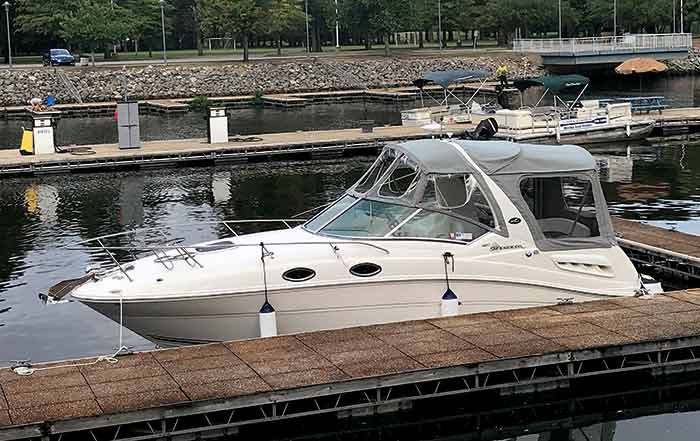
Sherry Whitten went from sail to power and now gets more use — and enjoyment — from it.
I've been a boater all my life, and a sailor since I was 14. At one point, our family owned a fleet of boats — two kayaks, a 420 sailing dinghy, a bass boat, a pontoon boat, and a 1992 Hunter 30 sailboat. Our boating is inland lakes — primarily the Tennessee River. Like Goldilocks, we sought conditions that were just right — not too hot or too cold, not too much wind or not enough, so Pleiades sat unused too often. She was a great boat, but she was lonely, and slip rental isn't cheap. In 2018, we reluctantly sold her and, soon after, started shopping for another boat.
My goal was a powerboat comfortable enough for two or three to overnight on and that I could park in our boathouse — essentially swapping fuel bills for a slip rental. We bought a 2007 Sea Ray 260 Sundancer. She has a generator, air conditioning, fridge, microwave, windlass, padded cockpit seating, and full camper canvas — creature comforts that were previously lacking. We've enjoyed many wonderful nights anchored out. This boat is just right for us, especially since I've been battling breast cancer this year and have some physical limitations.
I miss the great space we had belowdecks, and I really miss the joy of sailing, but I don't miss maintaining a boat that sits uncovered in the sun full time. No regrets.
— Sherry Whitten, Tennessee
Bring The Family
After we retired, my wife and I purchased a condo in Lake of the Ozarks, Missouri. We initially decided to keep our 20-foot Champion bass boat because we both enjoy fishing. When our adult children and grandchildren started visiting us, we realized the bass boat was not good for family excursions. The small, low-profile boat couldn't handle 6 to 8 people comfortably, or safely, to be on our lake with heavy boating traffic on the weekends.
With a bit of family pressure, I replaced my bass boat with a 26-foot tritoon with all the bells and whistles. Fishing became a bit of challenge and has cost me a few lures since my draft increased, but it was the best decision I ever made.
— Doug Kalusniak, Missouri
Bachelor Boater No More

Bruce Bachenheimer went for a family-friendly Island Packet sailboat after he got married and had kids.
I started with a Rhodes 22 sailboat that I purchased new in 1989 for daysailing on the Hudson River. In 1990, I purchased a Pearson 36 Cutter, which I lived aboard for several years and sailed from New England through the Caribbean to South America and back to Annapolis, Maryland. Now a family man, I own an Island Packet 27, which I bought in 2016 and use for coastal cruising in Long Island Sound and along the Rhode Island and Massachusetts coasts.
I went from a daysailer to a bluewater cruiser to now something in the middle. Each change met my lifestyle at different points. Now I typically do two two-week cruises with my family (wife, teenage daughter, and sometimes our dog) and a bunch of shorter/weekend trips — about half of those solo.
— Bruce Bachenheimer, New York
Life-Altering Decision

A 16-foot Carolina Skiff allows Jeffrey Bressler to enjoy the water despite becoming disabled in a car accident.
I've owned five boats, always moving up in size. I'm 63 now and cherish the many memories exploring Chesapeake Bay aboard No. 4, a Four Winns Vista 258. For years I hardly ever missed a full moon weekend, but after owning it for 17 years, moving up was again on the horizon. Then in 2016, I had an auto accident that left me seriously disabled. Unable to maintain or control Quitten Time, I reluctantly sold her.
I thought I was stuck in dry dock until I came across a 16-foot Carolina Skiff center-console. With my wife as first mate, we would be able to safely operate the boat. There are no more overnighters, but we have plenty of great times. When you get out there and hit that throttle, it doesn't matter what kind of boat you're in; the exhilarating thrill of being out on the water remains the same.
— Jeffrey Bressler, Maryland
My Versatile Singlehander
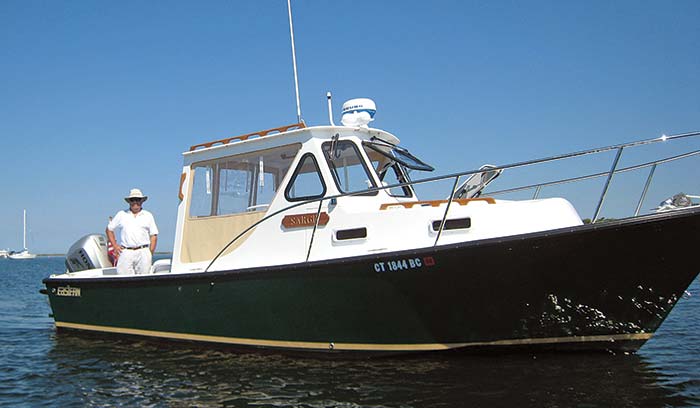
Dave Bristle aboard his 27-foot Eastern boat cruising Block Island.
I sailed from age 8 until about age 63. By then our Catalina 25 mostly sat in a slip as my significant other worked her busy real estate career and could rarely get away when the sailing weather was great. I could singlehand the Catalina but was never interested in solo activities.
It was time to go over to "the dark side," but I was very particular. I wanted an outboard-powered boat that could sleep two and party 10, had an enclosed head, an enclosable (but open) helm under a hardtop, and some classic downeast lines. Eastern Boats in New Hampshire custom-built my 27-footer just the way I wanted, perfect for quick trips to Block Island, Shelter Island, or the many other venues within easy reach of my home in southeastern Connecticut.
— Dave Bristle, Connecticut
Upsize, Downsize
When my wife and I retired to Florida in 2015, we considered what we wanted for our perfect boat: a versatile, nimble, and economical powerboat suitable for entertaining, fishing, limited overnight cruising, and exploring the shallower waters of southeastern Florida and the Bahamas. We also wanted a boat with a low profile to accommodate the numerous bridges along the Atlantic Intracoastal Waterway. We bought a Pursuit Offshore 345, and it was ideal. That is, until we realized how much we enjoyed the cruising opportunities available to us.
After a few years, we began to look for a larger boat in the 38- to 42-foot range that would provide more cruising range and comfort, and still fit within our original "perfect boat" parameters. After months of searching, we had an epiphany: In almost every destination, there were nice marinas or resorts with adjacent hotels. We considered the luxury and cost of parking the boat at a marina and lodging ourselves in a hotel versus the benefits and costs (operation, maintenance, and storage) of lugging a larger cruising-capable boat with us wherever we traveled. We decided to downsize to a boat that provided the comfort, range, and safety needed to continue our travels but stay at hotels and use our boat for day trips to fish, snorkel, or explore local restaurants, beaches, and islands. We simply keep the boat in a transient slip in a nearby marina.
We purchased a Pursuit DC 325 with an enclosed helm, air conditioning, marine head, plenty of seating and amenities, 300-plus mile range, and respectable seakeeping abilities. Now we have a boat that enables us to continue our long-range travels and is even better suited for evening sunset cruises to local waterside eateries, day trips to secluded beaches with grandchildren, and offshore fishing trips.
— Gary & Ingrid Rex, Florida
A Logical Progression
We are now retired and planning on traveling more by boat, so we wanted something economical to run, with fewer stairs and levels, and easier to handle with just the two of us. We sold our 40-foot Sea Ray Sedan Bridge and purchased a 30-foot Cutwater Sedan, which has a single diesel engine, bow and stern thrusters, and mostly one level living space. We can still take guests (even for overnight), but with smaller quarters. The two of us can handle the boat easily. We get great fuel mileage at hull speed, but she can get up and run if need be. We also like that we are together, even if I am fixing a meal and he is driving the boat. We can have heat or air as we travel, so this is the perfect boat for us at this point in our lives.
— Sally Leonard
Moving Up, Then Down
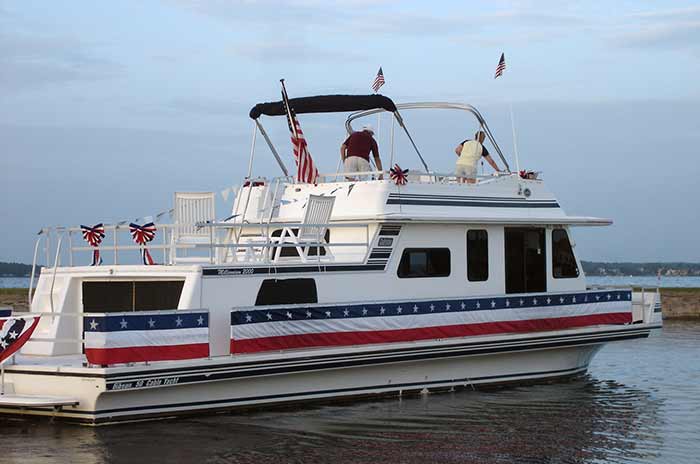
Sleepin Wit Da Fishes, in reference to a phrase used in The Godfather all decorated out for the 4th of July using decorations my wife made.
We downsized — big time. We had a 45-foot Catamaran Cruiser pontoon houseboat with a too-small 90-hp outboard engine. The interior layout was great, but the boat was uncontrollable in any wind over 10 mph. After 10 years on a lake near Houston, we sold it and moved up to a Gibson 50 Cabin Yacht with fiberglass hull and twin 390-hp inboards. We wanted to cruise the lake and visit restaurants on the shoreline. The Gibson gave us that flexibility — and with its 780 hp, could actually tow someone on skis! We enjoyed every moment of 10 years with her, but with my age (75) catching up to me, it was time to sell. We decided to leave the lake for good — but we are not out of boating. We have a 23-foot center-console rigged for saltwater fishing out of Port Aransas and Sargent.
— Bob Brink, Texas
Tips For Finding The Right 'Next Boat' For You
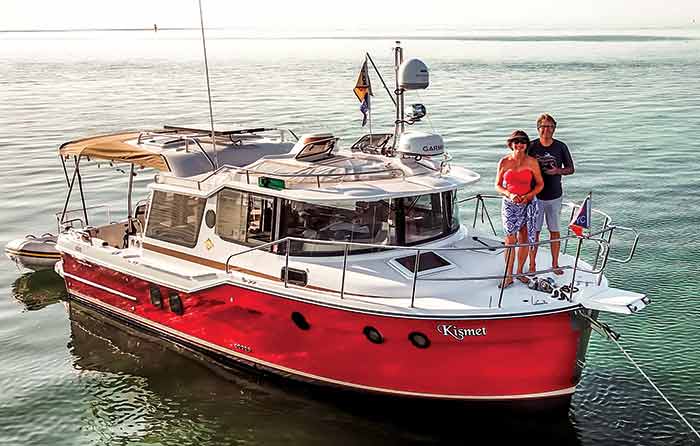
Jim and Lisa Favors are avid boaters who turned their passion for boating into high gear after retirement in 2005 — launching five years as liveaboards on a 40-foot Fathom expedition trawler. When they built a terrestrial home, they downsized to a 27-foot Ranger Tug before upsizing five years later to their current boat, a Ranger Tug R29.
Along the way they fostered an online resource for cruisers interested in trailerable boats with their blog Trailer Trawler Life. The couple also has written several books on the cruising lifestyle.
"We went from living onboard year-round for five years to owning a house and trailering our boat to places we hadn't been, or places we wanted to revisit," Jim says. "Everybody's different. It's just a matter of what your individual boating/cruising desires are." The Favors love to share their acquired knowledge of long-distance cruising, pocket trawlers, trailering, and "boaterhoming" (staying on your trailered boat in RV parks) to help boaters envision what to expect when upsizing or downsizing to a trailerable boat. This insight can be helpful to people considering a different boat to match a changing lifestyle — regardless of whether extended cruising or living aboard is the goal. "It is important to reassess wants and needs every so often to improve your experience on the water," says Lisa.
Here are some pro tips from the Favors:
- Make a list. Create a list of attributes and amenities you want on the boat. Identify the essentials and those that are wish-list items. The Favors did the same thing for the truck needed for hauling. "The goal is to better define wants and needs to get as many things in your favor on your new boat," Jim says.
- Do your due diligence. Dig into the research, beyond what the manufacturer presents online. For the Favors, that involved shopping at multiple boat shows to get on board contender boats. Informed dealers are at the show to answer questions.
- Tap the community. Find people who own boats you are most interested in, whether at the docks or online. They are the best source for unbiased opinions. They can also offer valuable insight into factory warranty and customer service from the manufacturer.
- "We found input from current owners useful in determining how responsive the factories are in addressing issues," Jim says. "A conversation with a couple we bumped into at a boat show helped sway our decision to go with a Ranger Tug. We wanted a boat that had good factory support and a strong community of boaters."
- Be budget-conscious. If you find the make and model that best suits your wants and needs, but the new boat price tag doesn't fit your boat fund allocation, consider a used or a later-model boat.
